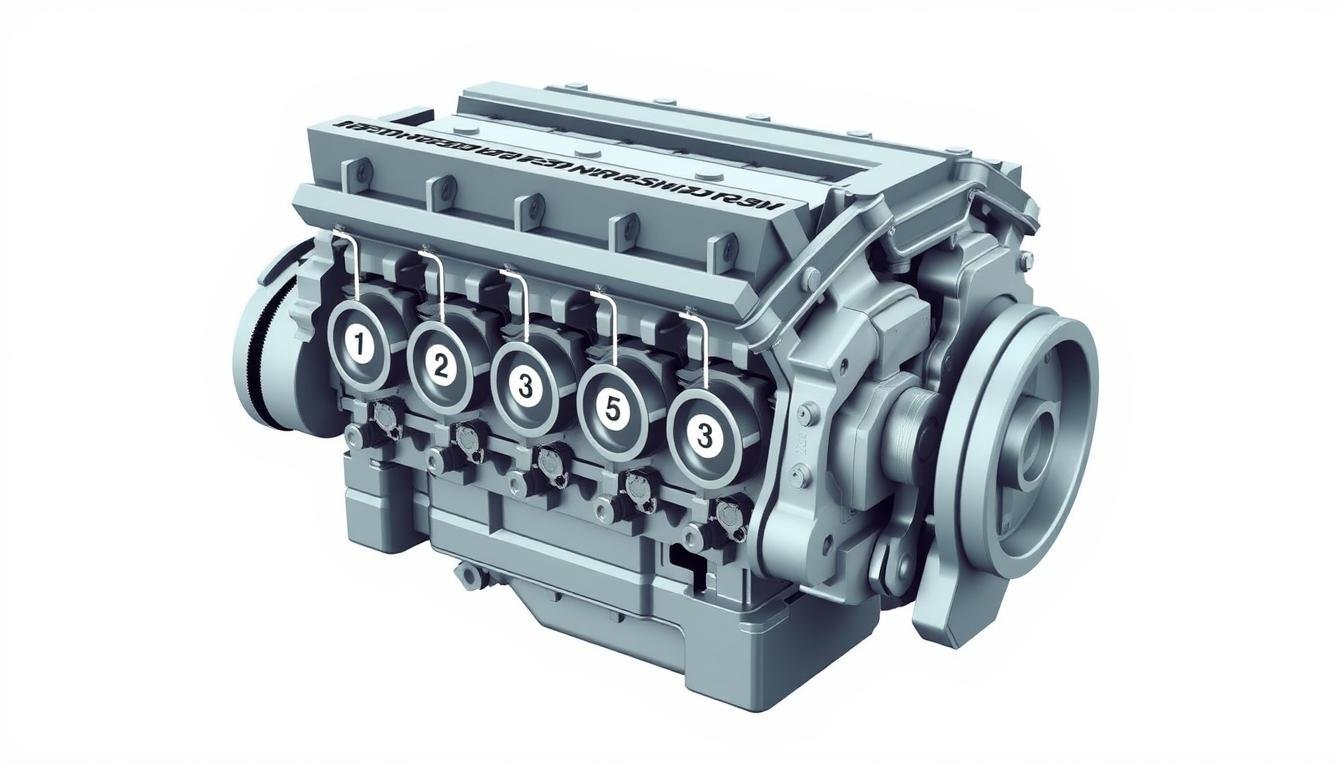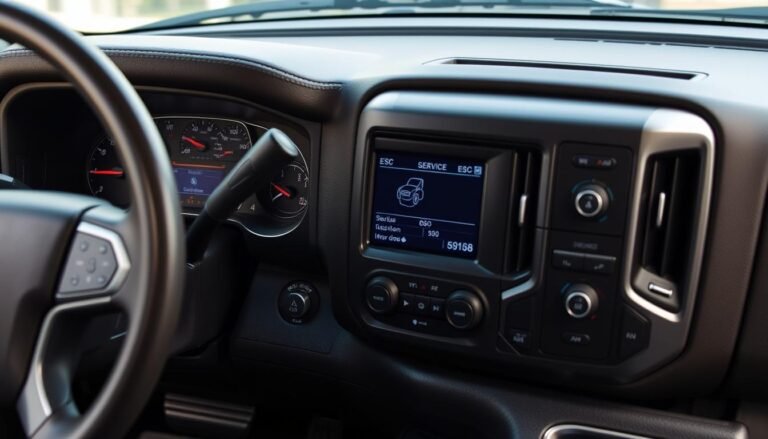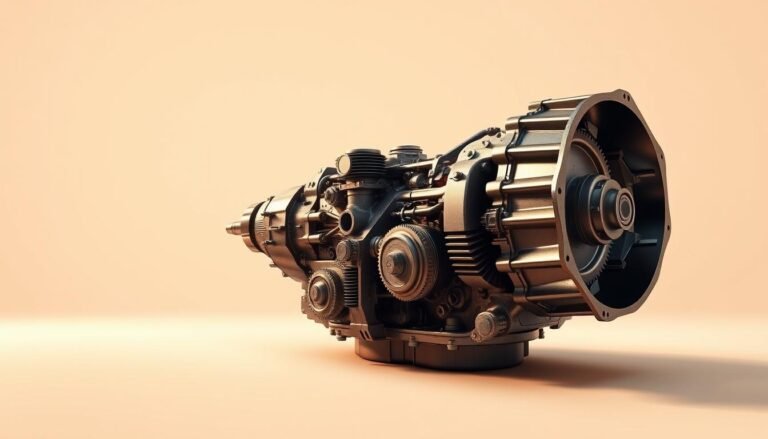Chevy 5.3 Firing Order Guide – Essential Info
The Chevy 5.3 firing order is 1-8-4-3-6-5-7-2. It’s key for your engine to work its best. This firing order is crucial for the health and troubleshooting of your Chevy 5.3 engine.
The engine is in popular trucks like the Chevrolet Silverado 1500 and GMC Sierra 1500. Getting the firing order right stops problems like bad power and misfires.
These problems can cause big engine trouble. This guide will show you why the right firing order matters.
You’ll learn how to check it when you care for your vehicle. And, you’ll find out how to fix any issues.
You will also see how some changes to the Chevy 5.3 engine can make it perform better. This info will help you keep your vehicle running well.
What is Firing Order and Its Importance?
The firing order is the sequence an engine’s cylinders ignite fuel to make power. For the Chevy 5.3 engine, it’s key for good performance and efficiency.
The right firing order ensures powerful, balanced output and efficient combustion. This greatly helps the engine last longer. It also avoids issues like misfires and wear.
What is Firing Order?
The firing order sets the ignition sequence for an engine’s cylinders. In V8 engines, like the Chevy 5.3, it typically goes 1-8-4-3-6-5-7-2. This means a cylinder fires every 90 degrees the crankshaft turns.
This sequence is crucial for combustion efficiency and smooth engine operation. It ensures optimal airflow and exhaust management too.
Why Firing Order Matters For Engine Performance
The firing order has a big impact on how well an engine performs. Getting it wrong can cause rough idles, stalling, or a power drop.
Signs of a bad firing order include engines that won’t start and very loud misfires. The right Chevy 5.3 firing order makes the engine run smoothly, lowers vibrations, and improves gas mileage.
A correct firing order keeps the engine balanced and the temperature even across cylinders. This leads to trusted performance.
Overview of The Chevy 5.3 Engine
The Chevy 5.3 engine, also known as the Vortec 5300, is famous for mixing power with efficiency.
This 5.3L V8 engine has powered General Motors trucks and SUVs since 1999. It’s well-loved by many.
Basic Specifications of The Chevy 5.3
If you love cars, knowing about the Chevy 5.3 is key. It comes with a 96 mm bore and a 92 mm stroke.
With horsepower ranging from 270 to 320, it’s great for towing or everyday driving. Here’s a quick look at its main specs:
| Specification | Details |
|---|---|
| Engine Type | 5.3L V8 (Vortec 5300) |
| Bore Size | 96 mm |
| Stroke | 92 mm |
| Horsepower | 270 to 320 hp |
| Torque | 305 to 335 lb-ft |
Common Applications For The 5.3 Engine
The chevy 5.3 engine fits well in various GM models. It’s in trucks like the Silverado and SUVs like the Tahoe and Suburban.
People like it for its strong performance and good gas mileage. Knowing this helps you use its power fully.
Chevy 5.3 Firing Order Explained
Knowing the firing order is key for your Chevy 5.3 engine’s top performance. It tells us which cylinder fires when.
For Chevy V8 engines, they use a 1-8-4-3-6-5-7-2 sequence. This setup boosts balance and power, making the engine run smoother.
The Standard Firing Order For Chevy V8 Engines
Chevy V8 engines, like the 5.3, use a 1-8-4-3-6-5-7-2 firing order. This pattern spreads out the power strokes, making the engine efficient and stable.
There’s a 90-degree interval between firings in this 720-degree turn setup. This helps increase power and save fuel.
Specifics of The Chevy 5.3 Firing Order: 1-8-4-3-6-5-7-2
The chevy 5.3 firing order, 1-8-4-3-6-5-7-2, is vital for the engine’s performance. It ensures power is evenly dished out.
This reduces vibrations and keeps the engine steady. Knowing this order helps solve issues like misfires caused by mixed-up spark plug wires, keeping your engine at its best.
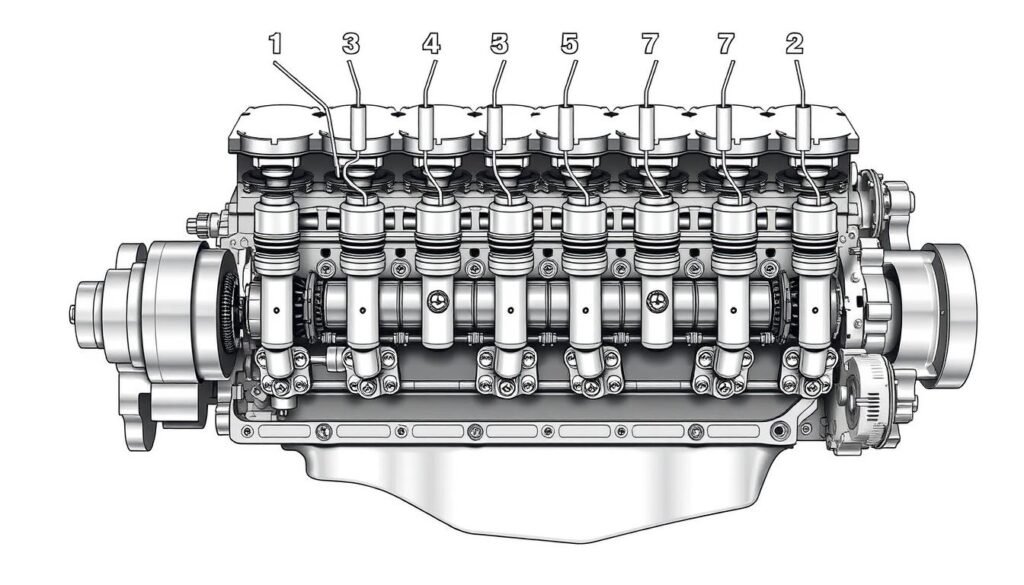
Comparing Firing Orders Across Different Engine Models
Knowing the firing order of Chevy engines is crucial for both mechanics and DIY fans. It significantly impacts engine performance and efficiency.
For example, the Chevy 5.3 engine uses a 1-8-4-3-6-5-7-2 firing order. However, other models have different orders that affect how they function.
Firing Order For Other Chevy Engines
Many Chevy engines, especially the V8s, share the 5.3’s firing order. Below is a list comparing the firing orders:
| Engine Model | Firing Order |
|---|---|
| Chevy V8 | 1-8-4-3-6-5-7-2 |
| Chevrolet Small Block | 1-8-4-3-6-5-7-2 |
| Chevrolet Big Block | 1-8-4-3-6-5-7-2 |
| Oldsmobile V8 | 1-8-4-3-6-5-7-2 |
| Pontiac V8 | 1-8-4-3-6-5-7-2 |
| Chevrolet LS Engine | 1-8-7-2-6-5-4-3 |
Differences Between LS and Vortec Engine Firing Orders
LS and Vortec engines have unique firing orders for different reasons. The LS engine’s order is 1-8-7-2-6-5-4-3, improving high-RPM performance by reducing internal engine stress.
On the other hand, the Vortec sticks with the 1-8-4-3-6-5-7-2 order. This mirrors the classic Chevy engines. This knowledge helps in picking the right parts for your engine.
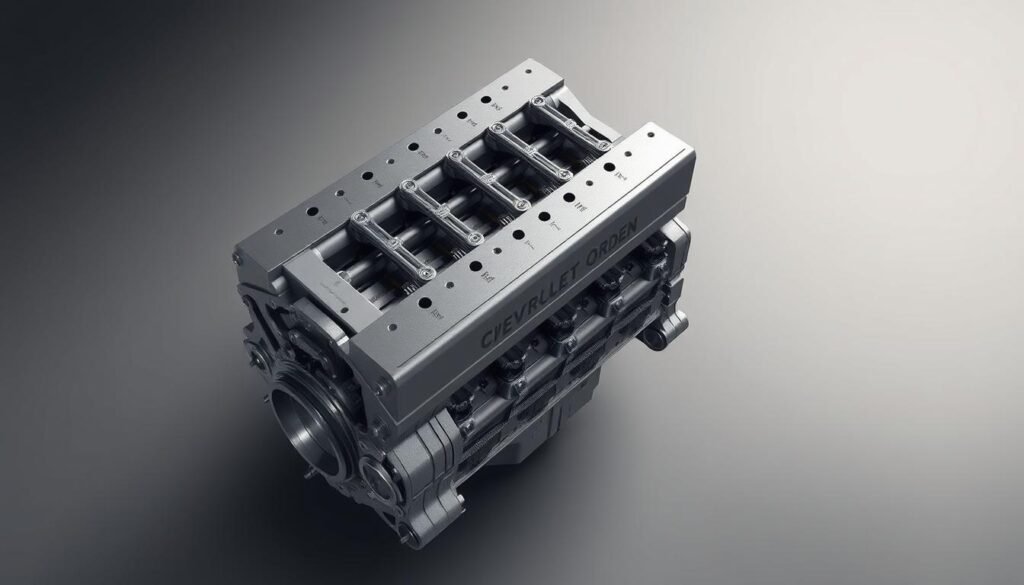
Common Issues Related To Incorrect Firing Order
An incorrect firing order can harm your engine’s performance. It’s crucial to understand these troubles for your engine’s health.
The chevy 5.3 firing order issues might cause your engine to run poorly or even stall. Identifying these signs early is key to fixing firing order problems and keeping your ride smooth.
Symptoms of Firing Order Misconfiguration
When the firing order is off, your car may not act right. Here’s what to watch out for:
- Engine turns over but won’t start: This issue has a 50% likelihood of occurring.
- Rough running or loud misfires: This is indicative of a 70% likelihood of faulty firing order.
- Loss of power or stalling: A common signal with a 60% chance of association with firing order problems.
- Misfiring cylinders typically show a temperature differential of 10-20 degrees Fahrenheit cooler than firing cylinders.
Troubleshooting Common Firing Order Problems
Here are steps to fix firing order problems:
- Check spark plug connections and ensure they are secured correctly. Usage of numbered spark plug wire markers can assist in achieving accurate placements.
- Examine the wiring layout for the firing order. Misrouting affects an estimated 20-30% of DIY repairs.
- Utilize diagnostic equipment to assess any trouble codes that may indicate a misfire, such as P0300, which suggests random/multiple cylinder misfires.
- Monitor the long-term fuel trim (LTFT) and short-term fuel trim (STFT) values for clues on inefficient combustion or lean conditions.
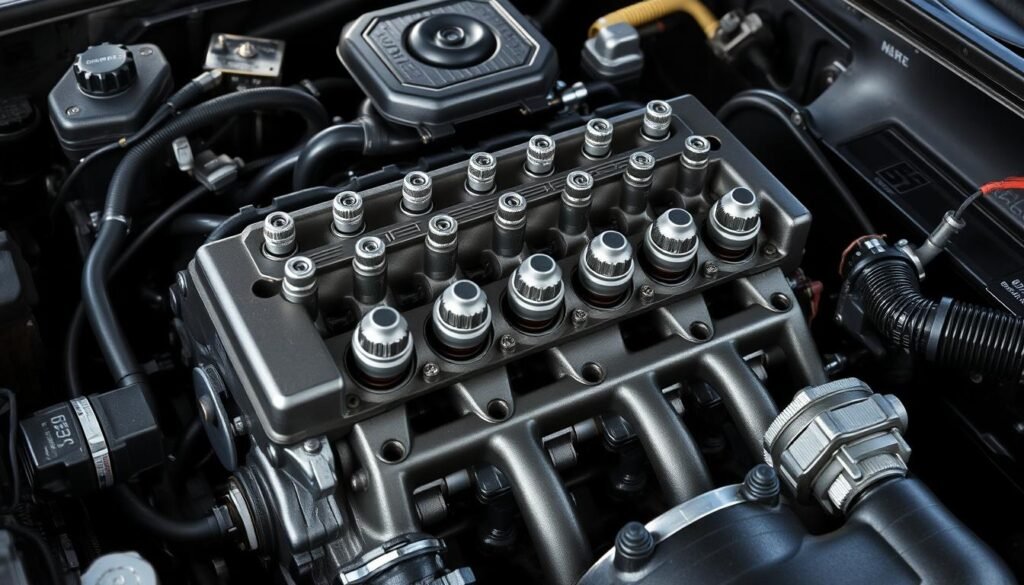
How To Ensure Proper Firing Order During Maintenance
Keeping the right firing order is key for your engine to work its best. By taking the right steps, checking the firing order can be simple.
You’ll want to label spark plug wires, use markers, and check a firing order chart. This avoids mistakes when taking care of your engine.
Steps To Check Firing Order Correctly
- Identify your engine’s firing order. For Chevy engines, the standard firing order is 1-8-4-3-6-5-7-2.
- Label each spark plug wire using spark plug wire markers to prevent confusion during reassembly.
- Remove the spark plug wires one at a time while replacing them with correct labels.
- Compare your current set-up with the specified firing order chart to ensure accuracy.
- After confirming that all wires are correctly positioned, reconnect them to their respective spark plugs.
Using Spark Plug Wire Markers For Accuracy
Spark plug wire markers are crucial for keeping the firing order right. They help stop ignition crossfire, which happens when wires get mixed up.
It’s best to replace wires one by one and label them to dodge mistakes later on. This keeps your engine running well by making sure wires are right. It prevents engine issues like misfires or stalling.
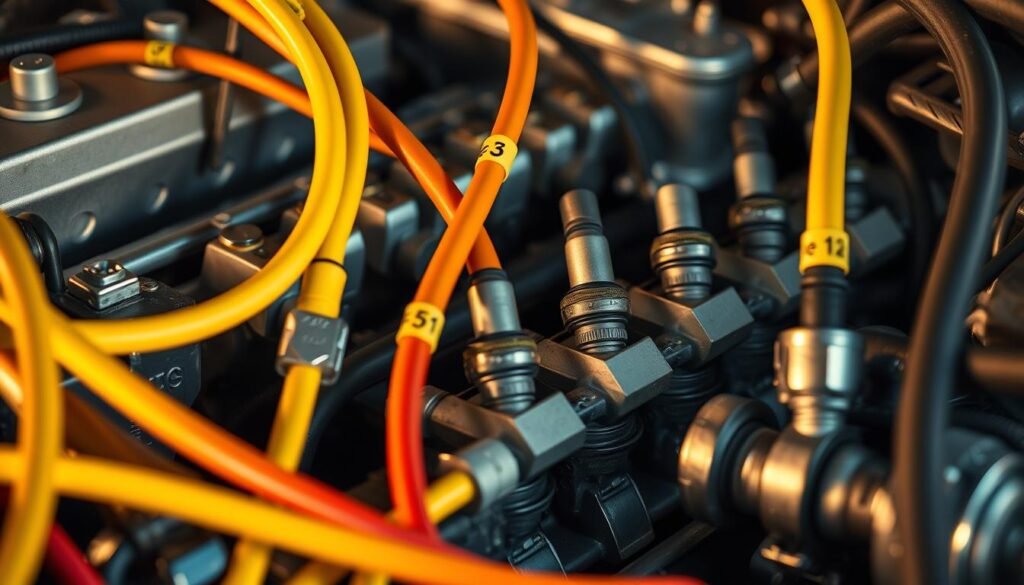
Popular Modifications For The Chevy 5.3 Engine
The Chevy 5.3 engine is a great base for those looking to boost their car’s power. It’s known for being flexible and strong, especially with the right mods.
There are many upgrades available to improve power and efficiency, keeping the engine reliable. Knowing your options helps you choose the best ways to enhance your vehicle.
Performance Upgrades To Enhance Output
For the 5.3 engine, some mods really make a difference in power and torque. Here are a few top choices:
- Cold Air Intakes: More airflow to the engine boosts both efficiency and horsepower.
- Upgraded Camshafts: Special camshafts increase performance in the 1,600-6,600 RPM range, adding lots of horsepower.
- Performance Exhaust Systems: Better exhaust flow raises horsepower and torque, key for getting the most from your mods.
With the right performance upgrades, a 5.3 engine can easily surpass 425 horsepower. This requires smart tuning and the correct parts.
Choosing The Right Aftermarket Components
Choosing the right parts is crucial for chevy 5.3 mods. Pick components that boost efficiency and match your engine’s needs.
Consider these important factors:
- Injector Ratings: Original injectors support 22-25 pounds. For more power, you’ll need injectors that can handle more fuel.
- Performance Fuel Pumps: A strong fuel pump is needed for setups aiming over 430 whp, ensuring enough fuel flow.
- Forged Pistons: For engines targeting beyond 800 horsepower, forged pistons offer more durability under high stress.
By choosing the right components and focusing on key upgrades, your Chevy 5.3 engine’s performance can reach new heights.
Quality parts mean an engine that’s not only more powerful but also reliable, whether on the street or track.
Enhancing Engine Performance with Proper Firing Order
Knowing the right firing order is key to boosting your Chevy 5.3 engine’s performance. This order affects power and efficiency a lot.
By tweaking the firing order, you can improve fuel usage and how the engine responds. This leads to better engine performance.
Impact on Power Output and Efficiency
The firing order plays a big role in how well V8 engines, like the Chevy 5.3, work. The usual order of 1-8-4-3-6-5-7-2 spreads power evenly. This makes for smooth running and less shaking.
If the order is wrong, the engine might run poorly or lose power. The right firing order keeps engine strokes in sync, increasing power.
Modification Suggestions To Optimize Firing Order
To make the firing order even better, think about some changes. Switching to hydraulic roller cams with the LS order (1-8-7-2-6-5-4-3) helps a lot.
It cuts down on shake from the crankshaft and raises efficiency. Such tweaks boost performance, ensuring a smooth, powerful ride.
Tools Required For Adjusting Firing Order
To fix the firing order, you need the right tools. You’ll need basic hand tools and special diagnostic gear.
These help you get to engine parts and find problems. Knowing your tools is key for working on your Chevy 5.3 engine.
Essential Tools For Maintenance and Repair
Here are the tools you need for precise firing order work:
- Torque wrench – essential for accurate torque specifications on spark plugs and other components.
- Socket set – provides the necessary sockets for various nut and bolt sizes in your engine.
- Spark plug wire separators – help keep plug wires organized to prevent confusion during reassembly.
- Digital multimeter – useful for testing electrical components related to ignition and firing order.
- Infrared thermometer – allows for checking engine temperature during diagnostics.
- Vacuum gauge – helps assess engine performance and identify issues related to firing order.
Using Diagnostic Equipment Effectively
To solve firing order problems, using diagnostic tools right is crucial. Here is how to use these tools well:
- Connect the multimeter: Start with the ignition system. Check for voltage at the ignition coils to confirm proper function.
- Monitor engine temperature: Use the infrared thermometer to ensure that the engine is running within the normal temperature range.
- Test for misfires: Connect a scanner to read error codes. Specific codes can help identify which cylinder is misfiring.
- Inspect spark plug wires: Ensure that all wires are correctly routed according to the firing order. Use separators if necessary.
Having the right tools and knowing how to use them can fix firing order issues. Learning about each tool’s use will make your engine run better.
| Tool | Purpose | Importance |
|---|---|---|
| Torque Wrench | Ensures proper torque on spark plugs | Prevents over-tightening or loosening |
| Digital Multimeter | Tests electrical components | Identifies issues in ignition system |
| Infrared Thermometer | Measures engine temperature | Helps with identifying overheating |
| Spark Plug Wire Separators | Keeps wires organized | Reduces chance of misrouting |
| Socket Set | Accesses various fasteners | Essential for removing components |
Chevrolet 5.3 Firing Order Diagram and Visual Guides
Knowing the firing order and cylinder layout is key for your Chevy 5.3 engine’s performance.
The chevy 5.3 firing order diagram shows cylinder numbers and the order spark plugs fire.
This helps quickly spot issues for better maintenance and repair. Visual guides help avoid mistakes in spark plug wire routing.
Learning Cylinder Numbering and Orientation
The Chevy 5.3 engine has a unique system for numbering cylinders. On the driver’s side, you’ll find cylinders 1, 3, 5, and 7. The passenger’s side has cylinders 2, 4, 6, and 8.
Cylinder 1 fires first, at the engine’s front. Then cylinders follow in order: 8, 7, 2, 6, 5, 4, and 3, in a clockwise direction. This order is key for the engine’s proper timing and balance.
Visual Aids For Correct Plug Wire Routing
Correctly routing spark plug wires is crucial to avoid engine misfires and keep things running smoothly. A chevy 5.3 firing order diagram ensures wires are perfectly placed.
This minimizes engine vibration and improves combustion efficiency. For correct ignition timing, the rotor must line up with cylinder one’s terminal at top dead center.
Always check visual guides for engine maintenance for clear instructions on maintenance tasks.
Conclusion
Knowing the Chevy 5.3 firing order is key for top engine performance and trusty operation.
This order, 1-8-4-3-6-5-7-2, is essential for how power is made and given to your car’s systems. It boosts efficiency and makes your engine last longer.
It’s important to keep an eye on your firing order for good engine care. Checking it helps you spot misfires, like the P0306 code which shows a problem in cylinder 6.
Along with regular engine care, this can make your vehicle more reliable and cut down on repair costs.
Using this guide in your maintenance routine lets you handle small fixes and big repairs with ease.
Learning about your Chevy 5.3 and keeping the right firing order top of mind brings big rewards.
With this knowledge, you can look forward to enjoying a well-performing vehicle for many years.
FAQs
What is the firing order for a Chevy 5.3 engine?
For the Chevy 5.3 V8 engine, it is 1-8-4-3-6-5-7-2.
Why is the firing order important for my Chevy 5.3?
It keeps the engine balanced and efficient. An incorrect order can cause wear, lower power, and bad performance.
How can I identify the firing order on my Chevy 5.3?
Check your spark plug wires against a firing order chart. Labeling the wires helps avoid mix-ups during maintenance.
What are the symptoms of an incorrect firing order?
Look out for rough running, misfires, trouble starting, and stalling. These signs mean you should check your firing order and wiring.
How does the firing order differ among Chevy engines?
Chevy engines use different firing orders. For example, GM’s LS engines use 1-8-7-2-6-5-4-3, unlike the Vortec’s like the 5.3.
What modifications can improve the performance of a Chevy 5.3?
Try adding cold air intakes, better camshafts, and upgraded exhaust systems. These can boost your engine’s horsepower and torque.
What tools do I need to adjust the firing order on my Chevy 5.3?
You’ll need simple hand tools along with gadgets like infrared thermometers and multimeters. These help in maintenance and finding problems.
Where can I find a visual guide for the Chevy 5.3 firing order?
Diagrams can show you the cylinder numbers and how to route spark plug wires for the Chevy 5.3 engine.

